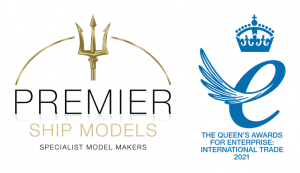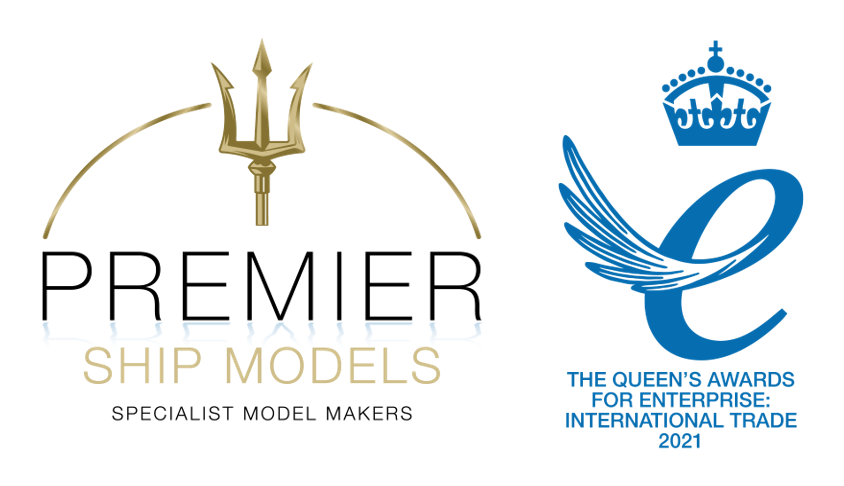2021 has been an incredibly productive year for Premier Ship Models. We successfully closed the most impressive deal in the history of our company, a six-figure contract for the brand-new Omani museum, ‘Across the Ages.’ This is even more of an amazing feat when the impacts of COVID-19 are considered. Progress was hindered as the workshop was forced to close temporarily, however, we still completed the assigned contract, and built nine models to be displayed in the museum, each varying in scale.
The nine models were (model length in millimetres, then width, then height):
- Jewel of Muscat (1,850mm, 702mm, 1,950mm)
- Imaum (1,669mm, 602mm, 1,154mm)
- Baghla Suri (1,267 mm, 267mm, 1,467mm)
- Sultanah (1,233mm, 483mm, 1,367mm)
- Ship Model 1 – British (1,013mm, 450mm, 776mm)
- Ship Model 2 – Dutch (759mm, 328mm, 637mm)
- Ship Model 3 – Portuguese (1,019mm, 259mm, 870mm)
- Bombay Grab (741mm, 336mm, 667mm)
- Omani Ship Batil (779mm, 145mm, 733mm)
As previously mentioned, the final client was the ‘Across the Ages’ Museum, which is a new national museum designed to celebrate the creation of Oman as a nation, praise human aspirations and inspire the younger generation of Omanis to connect and relate to their rich history. The building itself is of enormous scale, and includes galleries, a library, an auditorium, cafes and even spaces dedicated to research. An area is set aside for permanent exhibitions, and this measures at 9,000 square metres, and some of the galleries reach a staggering 20 metres in height. The Across the Ages Museum, therefore, is not to be taken lightly.
The subcontractor for the project was PICO, who aided us in communicating with the museum. They specialise in brand activation, and they blend skill sets across experience design, digital enablement and brand engagement, creating powerful activations which warrant far superior results. PICO also aided us in delivering progress reports as well as feedback from specialists, which dovetails into the next point of interest. In order for the models to be accepted into the museum, their historical-accuracy, detail and quality all had to be checked and subsequently approved by an appropriate subject expert. These nine models, therefore, are the best, most high-grade, intricate, realistic models Premier Ship Models have ever created.
Another independent subcontractor was particularly impressed, saying, “I was very pleased to receive your link to the video of the models, which are impressive. I had to pause the video a few times to admire the detail. It was great to finally have the opportunity to see all the models. I shall look forward to seeing them in person on a visit to Oman. Many thanks for sending the link.”
An extraordinary level of research was sunk into each model ship, in order to ensure the utmost accuracy and intricacy. To be approved by the maritime experts, each detail had to be finely tuned and subsequently perfected. The purpose of the model is to be on display in a museum, and so of course the precision must be absolutely spot-on. Achieving this was no small feat, and countless hours of study went in to make sure the models were not just acceptable, but excellent.
Our rendition of the Bombay Grab is a prime example of this intricacy. The ship itself was a cruiser of the Bombay Marine, which was the British East India Company’s Navy, and its name derives from the Arabic word ‘ghurāb,’ meaning raven. The vessel was usually of shallow draft, and rather wide in proportion to its length. It merged an indigenous hull form with a pointed prow, and could feature a bowsprit, however, the latter point wasn’t always the case. Due to its shape, the Grab could pitch sharply, especially when sailing head-on against waves. To combat this, the prow sides were left open to allow water to run off. Armament-wise, the Grab was fitted with a pair of 9-pounder guns which pointed forwards through port-holes which were cut in the bulkhead. They fired over the prow, and allowed the ship to fire on fleeing ships or front-facing hostiles. Grabs were also armed with 9-pounder guns on the broadsides, which were often used against pirates trying to board.
Each of these details have been brilliantly encapsulated in our rendition of the Bombay Grab. It’s adorned in a clean and subtle paint scheme, primarily consisting of yellow accents and a wooden finish. The hull is a crisp white and aids in accentuating the rest of the ship’s features, and the sizeable sails are plush and billowing, providing the model with an added layer of realism. The ship itself is absolutely exquisite, with every detail nailed down to a tee.
To achieve such a fine level of detail, laser technology was used to create the perfect shapes and measurements. This extremely precise method enables the model builders to make the model as realistic as possible, and, referring back to the maritime experts, ensures they’re of a good enough quality to be displayed in the Across the Ages Museum.
Notably, there are three more generic ships, ranging between British, Portuguese and Dutch origins. Oman has a lengthy history with these three nations, and the models not only represent the past relationships, both poor and prosperous, but also international trade and future commercial collaboration. They represent the progression and growth between Western Europe and the Middle East.
In 1507, Portugal seized control of Oman from the coast, and they transformed it into a highly important landing stage as part of their Indies spice trade. Portugal was dominant in the region around Oman’s capital city, Muscat, between 1507 and 1650, and this was down to the crucial geographical position of Oman. Strategically, Oman was located in a very important place in regards to the eastern trade routes. It wasn’t until the mid-17th century that the Omani tribes were able to drive the Portuguese out of Muscat indefinitely. Our stunning Portuguese Galleon represents the previously tumultuous relationship between Portugal and Oman, which has now evolved into a partnership which is far more constructive. The intricate rigging furthers the ship’s realism, whilst the billowing white sails and polished wooden hull make the model a beautiful sight. With an unbelievable level of accuracy, this Portuguese Galleon is sure to catch the eye of many people venturing through the museum.
– Portuguese Galleon
In regards to the Netherlands, their trade relations with Oman date back to around 1650. In 1651, the first ship from the Netherlands visited Oman, and trade relations at the time were solely based on rare commodities such as ivory and pearls, as well as more conventional things like rice, spices and even dried fish. Nowadays, the relations between the two countries are as strong and diverse as ever. In particular, Royal Dutch Shell is active in Oman and possesses a share of an enormous 34% in Petroleum Development Oman, which is the main company responsible for oil and gas exploration in the country. The two nations also collaborate in sectors such as general trade, transport, technology, logistics, security, and even infrastructure and agriculture. Additionally, the Port of Rotterdam is heavily involved with the advance of the industrial Port of Sohar via a joint venture between the Dutch and Omani governments. This array of associations reflects the strong bond between the two countries, and this strength is reflected in our rendition of the Dutch ship model. Its broad wooden structure is crisp and clean, and the polished aesthetic starkly contrasts the billowing white sails. Lengths of intricate rigging line the upper parts of the ship, adding to the sense of realism, and it features a beautiful white hull to round off the look.
– Dutch Ship
Much like Portugal, British relations with Oman have had their ups and downs through the years. Towards the end of the nineteenth century, Muscat was becoming increasingly pressured by British influence, through a series of treaties. The sultan agreed to consult Britan, but this would ultimately lead to frustration in future sultans. This was due to the fact that Omani sources of revenue were essentially absorbed by the British, and so the sultans couldn’t pay subsidies to the tribal sheikhs of other Arabic countries. Rebellions followed, with a number of attacks being staged in and around Muscat. In 1895, the British vowed to protect Sultan Faisal bin Turki, Oman’s sultan between 1888 and 1913, from tribal attacks. By keeping the sultan alive and in power, the British were essentially able to exert imperial control throughout Oman. In the years that followed, Britain would lose interest in Oman, before returning in the 1950s due to the prospect of oil, and eventually collaborating to overthrow Sultan Said bin Taimur in 1970. It was in 1951 that Oman gained independence from Britain, through the Treaty of Friendship, Commerce and Navigation, however, the two nations remain close allies to this day, with each possessing an embassy in the other’s capital city. Their military relations are strategic, and trade relations are now extremely positive. Our British ship model represents the healing bond between the UK and Oman, with a highly intricate design and ornate red, green and yellow accents. The rigging is highly detailed, and the wooden hull is a crisp, clean white. The interior is very realistic, and furthers the beauty of the ship.
– British Ship
Through laser technology and our highly-skilled model makers, each of the nine ships possess a quality like no other. Each detail is finely measured, examined and executed, creating our best models to date.
COVID-19 certainly presented a multitude of challenges throughout the entire process; mainly delays to the opening of the museum, the temporary closing of the workshop, people having to work from home and so much more. However, Premier Ship Models have not only completed the task, but excelled. Each model is beautiful, and accurate, and utterly enamouring to look at and learn about. With the opening of the Across the Ages Museum, our models reflect our pride and gratitude in the sense that we’re able to present our talent in such a fantastic manner, in an amazing place.
Liaison between the Royal Consult of Oman, PICO, a multitude of subject experts, model-makers, the workshop and our UK office has led to the creation and delivery of some of the finest, most historically-accurate models you’ll ever see. A bold claim, but one we can say with confidence.
Aside from COVID, the project hasn’t been without its challenges. It was difficult to obtain visas for the model-makers to travel to Oman, as they are usually based in Mauritius. Building each model was of course time-consuming, as every millimetre had to be accurate, and of a quality good enough to be displayed in a museum. Countless hours of research have been poured into this massive collaboration, and with the conclusion in sight, Premier Ship Models has achieved a fantastic feat.
Overall, we could not be prouder of this wonderful opportunity and accomplishment. With the opening of the Across the Ages Museum this March, we look forward to seeing our models on display, and hope they serve as brilliant tributes to Oman, their relations with an array of different nations, and of course, their rich maritime heritage.
Commission your own model
If you would like to have your own bespoke model built, please complete the contact form below.
I am in Oman for a few days of consulting with the Ministry of Heritage and Tourism. Two days ago I visited the Oman Across Ages Museum and was able to see your ship models in person for the first time. They looked very good, congratulations to all your team.
– Tom Vosmer – Curator


